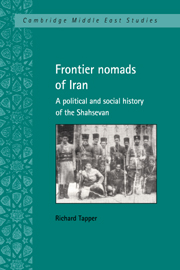Book contents
- Frontmatter
- Contents
- List of illustrations
- Preface
- Acknowledgments
- Note on transliteration
- Glossary
- 1 Writing tribal history
- PART I The Safavid state and the origins of the Shahsevan
- PART II The rise of the Shahsevan confederacy
- PART III The Shahsevan tribes in the Great Game
- PART IV The end of the tribal confederacy
- Appendices
- Bibliography
- Index of topics
- Index of places, peoples, persons, dynasties, parties, companies
- Index of authors quoted or discussed
- Index of tribal names
- Plate section
PART I - The Safavid state and the origins of the Shahsevan
Published online by Cambridge University Press: 05 March 2012
- Frontmatter
- Contents
- List of illustrations
- Preface
- Acknowledgments
- Note on transliteration
- Glossary
- 1 Writing tribal history
- PART I The Safavid state and the origins of the Shahsevan
- PART II The rise of the Shahsevan confederacy
- PART III The Shahsevan tribes in the Great Game
- PART IV The end of the tribal confederacy
- Appendices
- Bibliography
- Index of topics
- Index of places, peoples, persons, dynasties, parties, companies
- Index of authors quoted or discussed
- Index of tribal names
- Plate section
Summary
[Shah ʿAbbas I] had been early compelled to repress the ambition of the principal chiefs of the Kûzel-bash tribes, and had put several of them to death. He sought another defence against the effects of their turbulence, by forming a tribe of his own, which he styled Shah Sevund, or ‘the king's friends’; and he invited men of all tribes to enrol themselves in a clan, which he considered as devoted to his family, and therefore distinguished by his peculiar favour and protection. Volunteers could not be wanting at such a call: and we have one instance often thousand men being registered by the name of Shah-Sevund in one day. This tribe, which became remarkable for its attachment to the Suffavean dynasty, still exists in Persia, though with diminished numbers. It could once boast of more than a hundred thousand families.
Sir John Malcolm, History of PersiaThe history of the Shahsevan since the early eighteenth century is fairly well documented, but their origins are obscure. They appear to be a collection of tribal groups brought together in a confederacy some time between the sixteenth and the eighteenth centuries.
By the twentieth century, they had acquired three rather different versions of their origins.
- Type
- Chapter
- Information
- Frontier Nomads of IranA Political and Social History of the Shahsevan, pp. 35 - 38Publisher: Cambridge University PressPrint publication year: 1997



